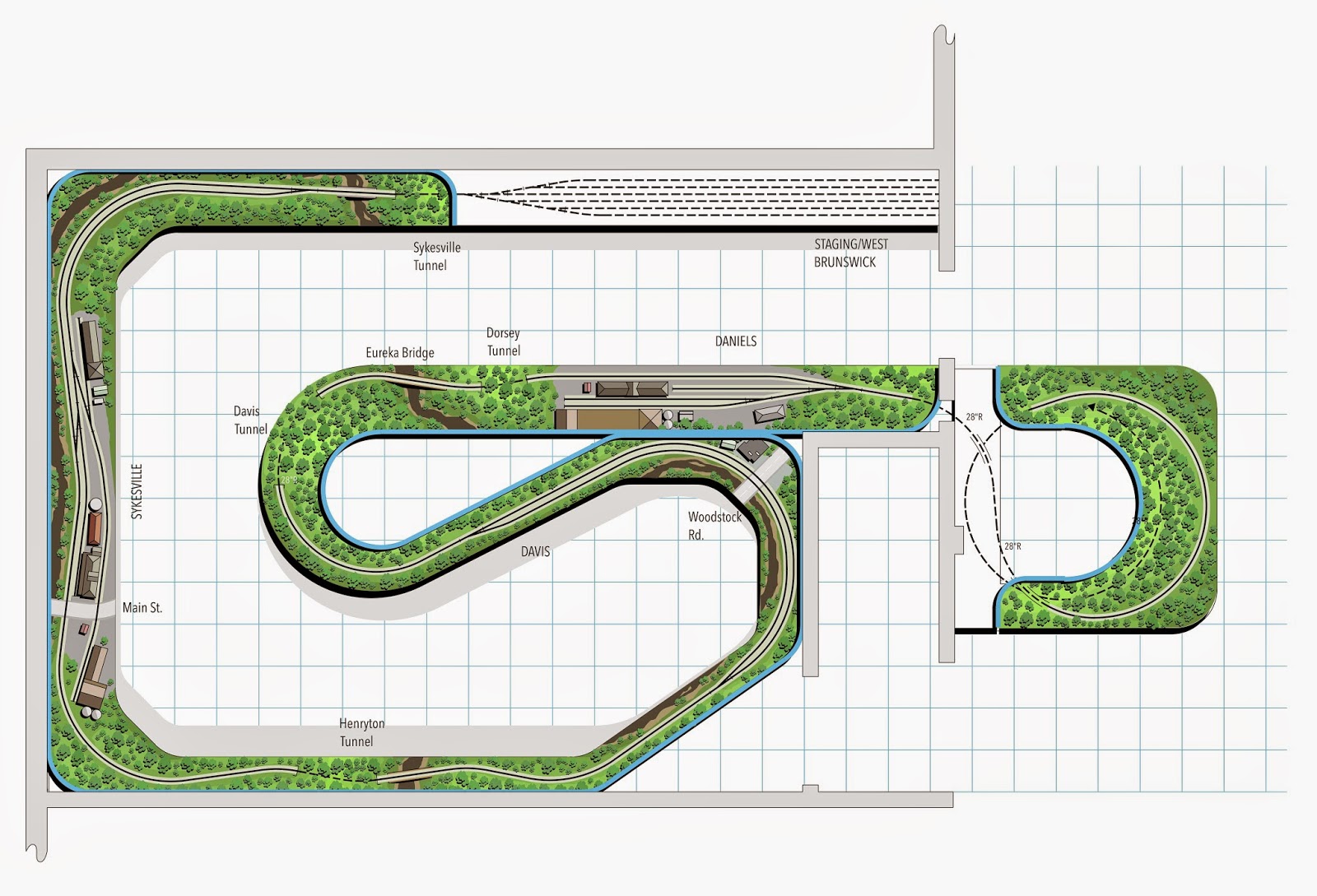I have all but memorized Tony Koester's book on the subject and have visited and operated on some great ones. But I've never quite been a fan of the multi-deck for my purposes. At least I don't think so. I was heartened when I read of Marty McGuirk's dismantling of his upper level and especially related to his reasons why, which he mentioned in his blog, and expounded upon in an issue of Model Railroad Hobbyist.
I do like having one deck at optimal working, viewing and operating height rather than two at compromised ones. I dislike having to worry about more lighting... and I do have to acknowledge the modest ceiling height with which I'm working. But most of all, I just prefer the look, or presentation if you will, of a single deck.
But I enlisted the help of Bob Sprague, planner extraordinaire, in a what-if, why-not scenario. I figured it's worth the beer that he charges! Hang on, here we go.
To be fair to Bob, he urged a plan that utilized the helix for staging areas with return loops and consistent direction, but it required a two-level gate across the 24" entry which is a feature I really dislike. That's it for now. A lot to think about. Wouldn't mind getting some viewpoints from you all out there! Do comment.
-30-
BONUS: RHETORICAL QUESTION OF THE DAY...
Did you know that you can learn more about the work of Marty McGuirk , Bob Sprague and Ted DiIorio by clicking on the sidebars for Central Vermont Railway, Annapolis Junction Railroad and Ma & Pa Railroad respectively?


So far, a year-and-a-half into it, I'm pretty pleased with my double-deck layout. The 212-foot mainline run (lower return loop to upper return loop) means the train is running a long while and actually feels like it's going somewhere. I've got 19" of separation (railhead to railhead) between my decks, and if there's one thing I've learned, it's "don't skimp on the distance between the decks." I've found myself poking my head into the far back of the lower deck (which is, max, 2 feet deep) on multiple occasions to check the alignment of switchpoints, to find a lost spike, to wire something on the underside of the upper deck, or to add a bit of tweezered scenery. If the distance were any lower, it'd be impossible to do some of that stuff!
ReplyDeleteA belated thanks, Gerry... (life has gotten in the way of railroading!)... to state the obvious, deck separation seems to be directly related to deck depth... the deeper the deck, the greater need for vertical separation... but truth be told, with a lower back that is much older than the rest of me, any type of bending, twisting or contorting isn't much fun... BTW, been watching each of your video updates... you seem to be doing just fine for a retired guy!
Delete...and BTW Leone, I would have expected some props from an old ad guy for my title on this post... you know, the old "Double your pleasure, double your fun, with Doublemint, Doublemint, Doublemint gum" ... or did that campaign never make it to the former home of the North Stars?
DeleteHi Jim:
ReplyDeleteI share your reservations about double-decked layouts, but given that your chosen prototype is so manageable, I think the extra distance between towns would enhance the operating experience. I also like the opportunity to model some long stretches of open-country running will more than compensate for the added complexity and the compromises to ideal viewing height.
Layouts with larger towns on two decks can become problematic to build and maintain - and those large towns can be difficult to operate because the decks are never at the ideal height. But your towns are very, very simple, so switching on either deck should not be burdensome. And since you're modeling mountainous territory, the points of view aren't artificial: one can be looking up towards a train hugging a mountainside, or down towards a train running through a valley, for example. Layout height becomes more of an issue on a flatland prototype, I think, because we're not used to seeing those prototypes from a "helicopter perspective".
I hope this helps...
Cheers!
- Trevor (Port Rowan in 1:64)
Thanks Trevor for your thoughtful answer... you've really looked at my LDEs... looks like your buddy Pierre is having the same conflict with planning his new layout.. I'll be curious to see how he proceeds, especially since he already has some layout building experience, unlike me... maybe you guys need some time at Harbord House to hash things out!
Delete